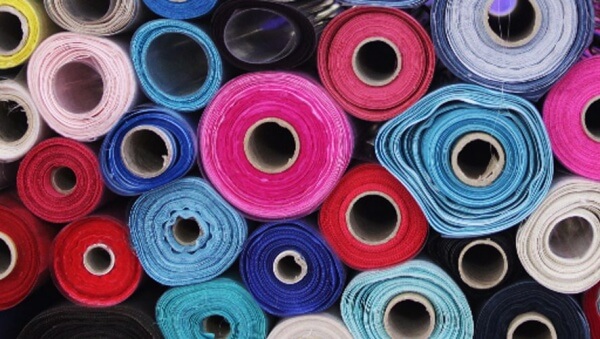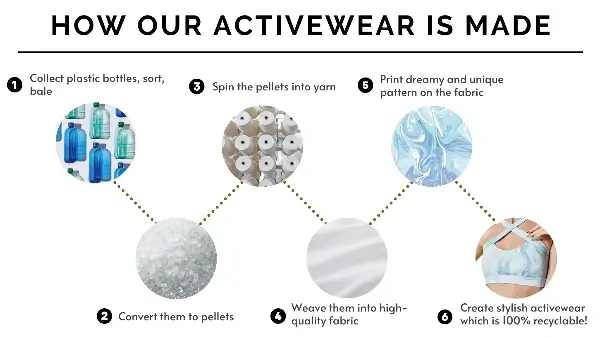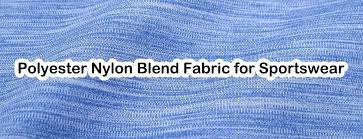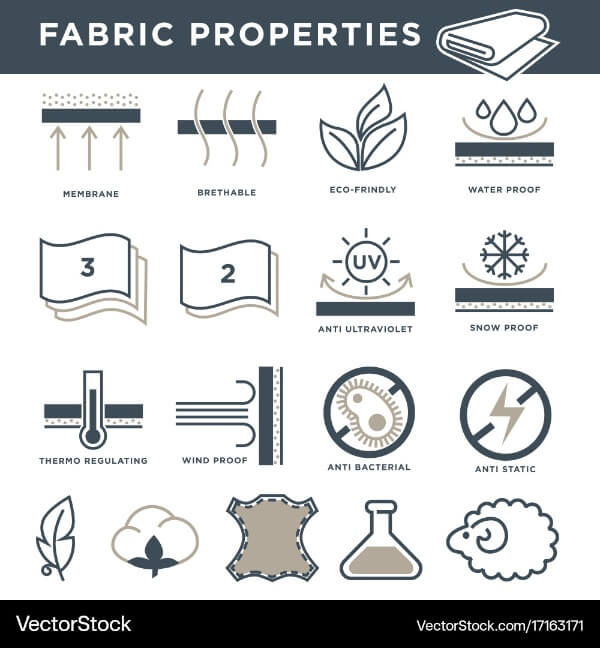Fabric Focus: Recycled Polyester vs. Nylon vs. Blends for Activewear?
Choosing the right fabric for activewear can feel overwhelming. Get it wrong, and performance suffers, costs rise, or sustainability goals are missed. Let me help you navigate these crucial choices for your wholesale needs.
Polyester offers great moisture-wicking and value, Nylon brings superior durability and stretch, while Blends provide tailored performance. Opting for recycled versions, especially GRS certified, significantly boosts sustainability, meeting growing market demand for eco-conscious activewear.

Making the right fabric decision is vital for any activewear line. It impacts everything from how the garment feels and performs during a workout to its environmental footprint and final price tag. As a manufacturer, I work with these materials daily, and understanding their nuances is key to creating products that resonate with customers and meet wholesale demands. Let's dive deeper into the specifics of recycled polyester, nylon, and popular blends to help you make the best choice for your brand.
Is Recycled Polyester the Go-To for Performance Activewear?
Struggling to find a fabric that performs well without breaking the bank? While virgin polyester works, its environmental impact is a growing concern. Recycled polyester emerges as a strong contender, offering a balance of performance, cost, and sustainability.
Yes, often. Recycled polyester (rPET) provides excellent moisture-wicking, durability, and colorfastness at a competitive price point. It's a sustainable choice made from post-consumer waste like plastic bottles, often available with GRS certification for verified recycled content.

Recycled polyester, frequently known by brand names like Repreve or simply as rPET, has become incredibly popular in activewear, and for good reason. It largely mirrors the performance characteristics of virgin polyester. It's hydrophobic, meaning it repels water rather than absorbing it. This translates to excellent moisture-wicking capabilities – it pulls sweat away from the skin to the fabric's surface where it can evaporate quickly, keeping the wearer dry and comfortable. It's also durable, resisting stretching, shrinking, and pilling, which is essential for garments that undergo intense activity and frequent washing. Polyester holds dye well, making it great for vibrant colors and prints, including sublimation printing. From a wholesale perspective, it's generally more cost-effective than nylon. The sustainability angle is a major plus; using recycled bottles reduces landfill waste and reliance on virgin petroleum. Look for Global Recycled Standard (GRS) certification to ensure traceability and adherence to environmental and social criteria.
| Feature | Virgin Polyester | Recycled Polyester (rPET) |
|---|---|---|
| Source | Petroleum (non-renewable) | Post-consumer plastic waste (e.g., PET bottles), pre-consumer waste |
| Performance | Good moisture-wicking, durable, quick-drying, colorfast | Similar performance to virgin polyester |
| Environmental Impact | Higher energy use, relies on fossil fuels | Lower energy consumption (~50% less), diverts plastic waste, reduces reliance on virgin resources |
| Cost | Generally lower | Can be slightly higher due to processing, but becoming more competitive |
| Certification | N/A for recycled content | GRS (Global Recycled Standard), RCS (Recycled Claim Standard) |
When Does Nylon Outperform Polyester in Activewear?
Need activewear that can withstand serious abrasion or requires maximum stretch and recovery? Polyester is tough, but sometimes you need something even stronger. Nylon steps in when superior durability and elasticity are non-negotiable.
Nylon is the choice for high-stress applications needing exceptional strength, abrasion resistance, and elasticity. It feels smoother and silkier than polyester but absorbs more moisture. Recycled nylon offers a sustainable edge for this premium fiber.

Nylon, a type of polyamide, was the first truly synthetic fiber and is known for its incredible strength and durability. It boasts excellent tensile strength and abrasion resistance, making it ideal for gear that takes a beating, like outerwear, leggings, or items rubbing against equipment. Nylon also has greater elasticity than polyester, meaning it can stretch significantly and return to its original shape effectively. This property, often enhanced with spandex, is crucial for form-fitting activewear like compression gear or swimwear. Many users prefer nylon's feel, often described as softer, smoother, and more luxurious against the skin compared to standard polyester. However, nylon is more hydrophilic than polyester, absorbing more water and taking longer to dry. It's also typically more expensive due to a more complex manufacturing process. Like polyester, recycled nylon options (like ECONYL®, made from fishing nets and other waste) are available and can be GRS certified, reducing environmental impact.
| Feature | Virgin Nylon | Recycled Nylon |
|---|---|---|
| Source | Petroleum (non-renewable) | Post-consumer waste (e.g., fishing nets, carpets), pre-consumer waste |
| Performance | Very strong, durable, high elasticity, smooth feel, absorbs some moisture | Similar performance to virgin nylon |
| Environmental Impact | Energy-intensive production, relies on fossil fuels | Reduces waste, lower energy/resource use compared to virgin nylon |
| Cost | Generally higher than polyester | Often higher than virgin nylon due to complex recycling process |
| Certification | N/A for recycled content | GRS (Global Recycled Standard), RCS (Recycled Claim Standard) |
Are Blends the Best of Both Worlds for Activewear Fabrics?
Finding that neither pure polyester nor pure nylon perfectly meets your needs? You might need polyester's wicking but nylon's stretch, or cotton's softness with synthetic durability. Fabric blends offer a way to combine the best properties of different fibers.
Often, yes. Blending fibers like polyester, nylon, spandex (elastane/Lycra), and even cotton allows manufacturers to create fabrics with specific, optimized characteristics for different activities, balancing performance, comfort, feel, and cost effectively.

Blends are extremely common in activewear because they allow us to fine-tune fabric properties. The most ubiquitous addition is spandex (also known as Lycra or elastane), which provides stretch and recovery. A typical performance tee might be 91% polyester and 9% spandex, offering moisture-wicking, durability, and flexibility. Leggings often use higher spandex percentages (like 73% Recycled Polyester / 27% Spandex or similar Nylon blends) for maximum stretch and compression. Cotton/spandex blends (e.g., 95% cotton/5% spandex) are popular for lifestyle activewear or low-impact activities, offering comfort and some stretch, though less moisture-wicking than synthetics. The GSM (grams per square meter) indicates fabric weight/thickness – higher GSM usually means more warmth and opacity. Stretch is also key: 4-way stretch (stretching crosswise and lengthwise) offers maximum freedom of movement and is preferred for most activewear, while 2-way stretch (stretching in only one direction) might suffice for more casual items.
| Common Blend | Typical Composition | Typical Use | Key Benefits |
|---|---|---|---|
| Polyester/Spandex | ~85-92% Polyester, 8-15% Spandex | Performance Tees, Shorts, Leggings, Sports Bras | Good wicking, durable, quick-dry, good stretch |
| Nylon/Spandex | ~75-85% Nylon, 15-25% Spandex | Leggings, Swimwear, Compression Wear, Sports Bras | Very durable, excellent stretch & recovery, smooth feel |
| Cotton/Spandex | ~95% Cotton, 5% Spandex | Lifestyle Tees, Cutoffs, Loungewear, Low-impact Yoga | Soft, comfortable, breathable, some stretch |
| Cotton/Polyester | Varies (e.g., 60/40, 50/50) | Hoodies, Sweatshirts, Casual Tees | Combines cotton comfort with polyester durability & wrinkle resistance |
How Do These Fabrics Stack Up on Key Performance Metrics?
Feeling lost trying to directly compare these fabric options? It's easy to get bogged down in details. A side-by-side look helps clarify which fabric excels where, guiding your wholesale purchasing decisions.
Polyester leads in moisture management and cost-effectiveness. Nylon offers unmatched durability and stretch. Blends allow customization for specific needs. Recycled options across the board enhance sustainability, a key factor for today's market.

Let's break down the core performance factors. Moisture-wicking: Polyester is king here due to its hydrophobic nature. Nylon wicks, but absorbs more. Blends depend on the dominant fiber. Stretch: Nylon has more inherent elasticity. Spandex is the key additive for high stretch in blends. Always look for 4-way stretch for optimal movement in activewear; 2-way stretch is less common and suitable mainly for casual styles. Durability: Nylon generally wins on abrasion and tear strength. Polyester resists pilling and holds shape well. Opacity: This depends heavily on knit construction, fabric weight (GSM), and color. Tighter knits, higher GSM, and darker colors increase opacity. Lightweight white fabrics (especially linen or some polyesters/nylons) can be sheer. Specific technologies exist to enhance opacity, particularly in polyester. Feel: Nylon is often perceived as softer and silkier. Polyester's feel has improved greatly with technology. Finishes like brushing (adds softness/warmth) or peaching (smooth, velvety feel) significantly alter texture. Cost: Generally, Polyester < Nylon. Recycled versions can sometimes cost slightly more than virgin counterparts. Blends vary based on composition. Sustainability: Recycled options (rPET, recycled nylon) are crucial for reducing impact. Look for GRS certification for verification.
| Feature | (Recycled) Polyester | (Recycled) Nylon | Common Blends (e.g., Poly/Spandex, Nylon/Spandex) |
|---|---|---|---|
| Moisture-Wicking | Excellent | Good (but absorbs more) | Varies (Good to Excellent depending on base) |
| Stretch & Recovery | Moderate (Good with Spandex) | Excellent (Especially with Spandex) | Excellent (due to Spandex) |
| Durability | Good (Resists pilling, shrinking) | Excellent (Abrasion/Tear resistant) | Good to Excellent (depends on base fiber) |
| Opacity | Moderate to Good (depends on weight/weave/color) | Moderate to Good (depends on weight/weave/color) | Moderate to Good (depends on weight/weave/color) |
| Feel/Texture | Can be slightly coarse, but soft versions exist | Smooth, soft, silky | Varies greatly with blend and finish |
| Cost Tier (Wholesale) | $ - $$ | $$ - $$$ | $$ - $$$ |
| Sustainability Focus | Recycled (rPET), GRS Certified | Recycled, GRS Certified | Recycled base fibers, GRS Certified |
Conclusion
Choosing between recycled polyester, nylon, or blends depends on your specific needs. Consider performance priorities, target cost, and the growing demand for sustainable options to make the best wholesale fabric choice.
Frequently Asked Questions (FAQ)
Q1: What is the Global Recycled Standard (GRS)?
A: GRS is an international standard that verifies recycled content in products (minimum 50%). It also sets strict social and environmental criteria for processing, including chemical restrictions, ensuring responsible production from source to final product.
Q2: Is recycled polyester or recycled nylon better for the environment?
A: Both offer significant environmental benefits over their virgin counterparts by reducing waste and reliance on fossil fuels. Recycled polyester often comes from plastic bottles, while recycled nylon can come from sources like fishing nets. The "better" choice depends on the specific product needs and sourcing availability, but both represent a positive step.
Q3: Which fabric is more breathable, polyester or nylon?
A: Generally, neither polyester nor nylon is as breathable as natural fibers like cotton or linen. Between the two synthetics, polyester's moisture-wicking often makes it feel more comfortable during intense sweat sessions as it moves moisture away faster. Nylon can sometimes feel slightly less breathable as it absorbs more moisture. Breathability in activewear is also heavily influenced by the fabric's knit structure (e.g., mesh panels).
Q4: What's the difference between 2-way and 4-way stretch?
A: 2-way stretch fabric stretches in one direction only (either horizontally or vertically). 4-way stretch fabric stretches in both directions – horizontally (crosswise) and vertically (lengthwise). For activewear requiring freedom of movement (like leggings or fitted tops), 4-way stretch is highly preferred for its superior flexibility and recovery.
Q5: Does recycled fabric perform as well as virgin fabric?
A: Yes, generally. High-quality recycled polyester and nylon are engineered to offer performance characteristics (like strength, wicking, durability) that are comparable to their virgin equivalents. Advances in recycling technology have made this increasingly possible.
